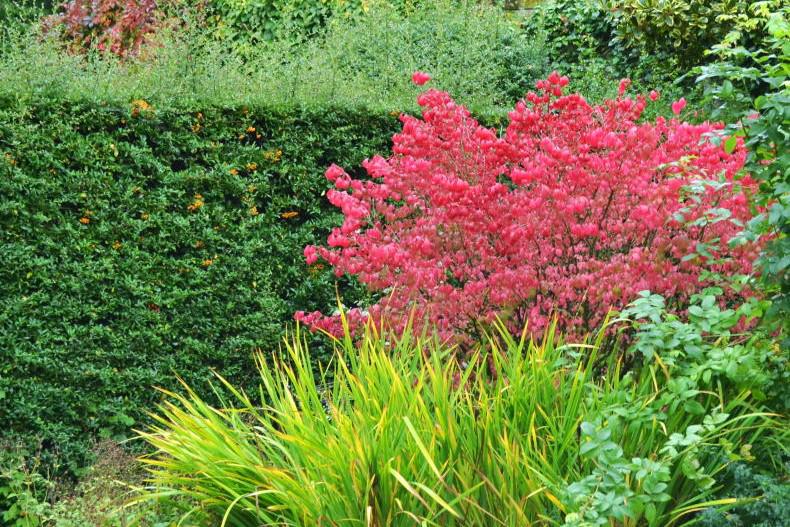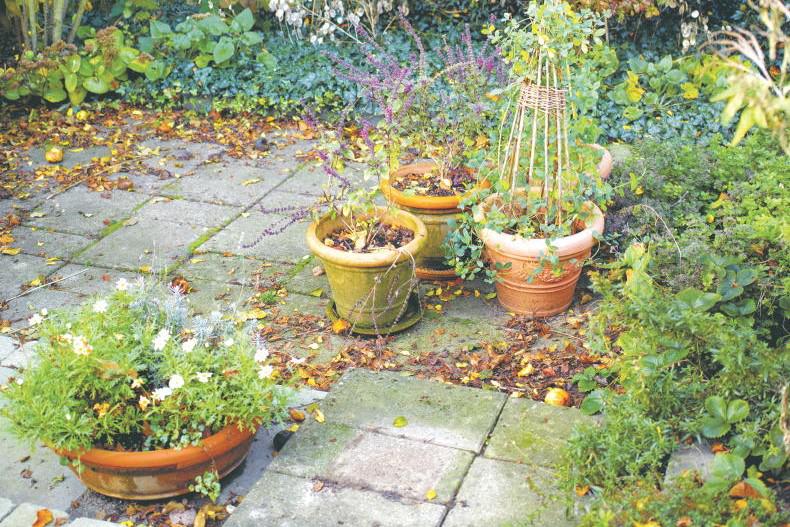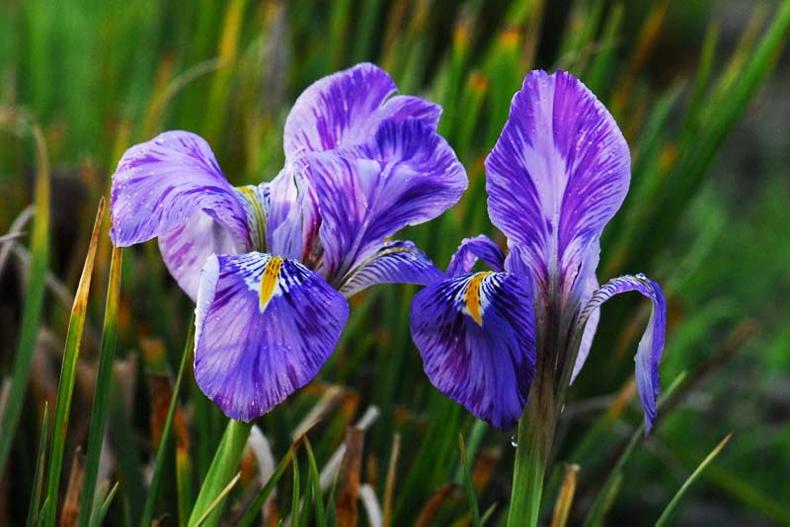Name: American sweet gum
The sweet gum forms a pillar of purple foliage from early autumn, slowly changing to shades of crimson red, orange, and sometimes yellow. The leaves last a long time on the tree and the show of colour is not over in a flash as it is with some autumn colour trees.
It is so good that it is grown especially for its colour and it is widely used as a street tree in its native America and in Europe. It is popular in California where it is staggeringly beautiful, but it is not native to California.
Botanical name: The American sweet gum, Liquidambar styraciflua, was introduced to Spain in the 16th century. It gets the name sweet gum from its production of a sweet-smelling gum. The gum hardens as it dries and forms a yellow material, like amber, and the name Liquidambar is derived from the liquid gum. The second part of the botanical name means ‘flowing with gum’.
The gum is used in perfume because of its sweet smell and was traditionally used to perfume gloves. The wood of sweet gum has a rich reddish brown colour and has been much used for furniture-making, especially as veneer for cabinets, and early radio and television sets.
Family: Sweet gum is a member of the witch hazel family, the Hamamelidaceae. Most of this family are very good for autumn colour, including notably the witch hazel itself, the Persian ironwood and the lovely fothergilla. While the foliage of all of these is similar in shape and structure, the foliage of sweet gum looks much like that of maple. It is divided into five pointed leaves. Maple species have pairs of leaves opposed to each other, while the leaves of sweet gum alternate along the twig.
Garden value
It is very common for young sweet gum trees to suffer damage by frost to the tips of the stems. The tree itself usually survives although young trees can be killed outright. The damage to the tips is soon replaced by new growth in spring. Liquidambar is fast-growing, well capable of 60cm in a growing season.
The shoots are grassy-green and often the top 20cm runs out of summer before it can mature. This is the part vulnerable to frost. Often the leaves at the tips of the young shoots are held well into January, as the tree struggles to ripen the soft twigs. Like most autumn colour trees, it shows better colour after a sunny summer and it is very good this autumn.
The sweet gum does get established in gardens despite initial setbacks. In this country, it grows to about half of its natural size of up to 25m, which makes it a fair-sized tree. Too big for small gardens but ideal for a rural garden where there is space to grow. It makes a great specimen or can be planted as a front tree of a group or belt of trees.
Growing sweet gum
It colours best in acidic soil, and in full sunshine, but it can be grown in limy soil as long as the soil is deep and does not dry out too much. At the same time, it does not like wet soil and the good winter drainage is essential. Plant it in autumn or spring and as a plant of good-size from a pot. It does not like to be disturbed so keep down weeds to a spread of at least one metre.
Ideally strawberry plants are best planted in late summer to give them the best chance to make plenty of new growth before winter.
Well-grown plants will have made several crowns, each of which will produce a truss of flowers and a reasonable first year crop. But now is a good time to plant if you did not get around to it earlier. The plants will still get settled before growth comes to a halt.

Ideally strawberry plants are best planted in late summer to give them the best chance to make plenty of new growth before winter. / Claire Nash
You can also pot up some plants at this time and force them into flower for an early crop in a glasshouse or tunnel next spring.
The plants in pots are left outdoors until January and then brought into the warmth to flower early. The plants for forcing should be as strong as possible to give a reasonable yield and runners that rooted near parent plants could be lifted or new runners bought. The forced plants can be planted outdoors after flowering to crop in subsequent years.
Trees, shrubs and roses
Planting can take place now for evergreens or in a few weeks for bare-root deciduous trees. Delay until spring in an exposed location to avoid the battering of winter gales, and also if the weather is wet and the ground becomes too wet. Check that trees are properly staked.
Fruit, vegetables and herbs
Apples and pears can be picked and stored, pears in flat boxes and apples in plastic bags, open at the neck. Over-mature vegetables should be chopped up and composted. Weeds should be removed and the ground dug over roughly to allow it to break down.
Flowers
If bedding has gone over, it can be removed soon in preparation for planting spring bedding. Also this is the main time for planting spring bulbs and containers for spring display. Perennial flowers can be planted or lifted and divided, retaining good performers.
Lawn
If moss has been a problem on lawns, it will be growing strongly now and sulphate of iron should be used to knock it back before winter. Autumn lawn fertiliser can be used or a low-nitrogen compound fertiliser to maintain some growth through the winter.
Greenhouse and house plants
Bring in all tender plants before the frost arrives. Most of the greenhouse crops can be cleared soon. Tidy up all debris and reduce watering to just keep pots from going bone dry. Place rooted cuttings in a bright position and any winter plants such as Christmas azaleas.
Read more
Gardening with Gerry: passion flower
Gardening with Gerry: misty blue
Name: American sweet gum
The sweet gum forms a pillar of purple foliage from early autumn, slowly changing to shades of crimson red, orange, and sometimes yellow. The leaves last a long time on the tree and the show of colour is not over in a flash as it is with some autumn colour trees.
It is so good that it is grown especially for its colour and it is widely used as a street tree in its native America and in Europe. It is popular in California where it is staggeringly beautiful, but it is not native to California.
Botanical name: The American sweet gum, Liquidambar styraciflua, was introduced to Spain in the 16th century. It gets the name sweet gum from its production of a sweet-smelling gum. The gum hardens as it dries and forms a yellow material, like amber, and the name Liquidambar is derived from the liquid gum. The second part of the botanical name means ‘flowing with gum’.
The gum is used in perfume because of its sweet smell and was traditionally used to perfume gloves. The wood of sweet gum has a rich reddish brown colour and has been much used for furniture-making, especially as veneer for cabinets, and early radio and television sets.
Family: Sweet gum is a member of the witch hazel family, the Hamamelidaceae. Most of this family are very good for autumn colour, including notably the witch hazel itself, the Persian ironwood and the lovely fothergilla. While the foliage of all of these is similar in shape and structure, the foliage of sweet gum looks much like that of maple. It is divided into five pointed leaves. Maple species have pairs of leaves opposed to each other, while the leaves of sweet gum alternate along the twig.
Garden value
It is very common for young sweet gum trees to suffer damage by frost to the tips of the stems. The tree itself usually survives although young trees can be killed outright. The damage to the tips is soon replaced by new growth in spring. Liquidambar is fast-growing, well capable of 60cm in a growing season.
The shoots are grassy-green and often the top 20cm runs out of summer before it can mature. This is the part vulnerable to frost. Often the leaves at the tips of the young shoots are held well into January, as the tree struggles to ripen the soft twigs. Like most autumn colour trees, it shows better colour after a sunny summer and it is very good this autumn.
The sweet gum does get established in gardens despite initial setbacks. In this country, it grows to about half of its natural size of up to 25m, which makes it a fair-sized tree. Too big for small gardens but ideal for a rural garden where there is space to grow. It makes a great specimen or can be planted as a front tree of a group or belt of trees.
Growing sweet gum
It colours best in acidic soil, and in full sunshine, but it can be grown in limy soil as long as the soil is deep and does not dry out too much. At the same time, it does not like wet soil and the good winter drainage is essential. Plant it in autumn or spring and as a plant of good-size from a pot. It does not like to be disturbed so keep down weeds to a spread of at least one metre.
Ideally strawberry plants are best planted in late summer to give them the best chance to make plenty of new growth before winter.
Well-grown plants will have made several crowns, each of which will produce a truss of flowers and a reasonable first year crop. But now is a good time to plant if you did not get around to it earlier. The plants will still get settled before growth comes to a halt.

Ideally strawberry plants are best planted in late summer to give them the best chance to make plenty of new growth before winter. / Claire Nash
You can also pot up some plants at this time and force them into flower for an early crop in a glasshouse or tunnel next spring.
The plants in pots are left outdoors until January and then brought into the warmth to flower early. The plants for forcing should be as strong as possible to give a reasonable yield and runners that rooted near parent plants could be lifted or new runners bought. The forced plants can be planted outdoors after flowering to crop in subsequent years.
Trees, shrubs and roses
Planting can take place now for evergreens or in a few weeks for bare-root deciduous trees. Delay until spring in an exposed location to avoid the battering of winter gales, and also if the weather is wet and the ground becomes too wet. Check that trees are properly staked.
Fruit, vegetables and herbs
Apples and pears can be picked and stored, pears in flat boxes and apples in plastic bags, open at the neck. Over-mature vegetables should be chopped up and composted. Weeds should be removed and the ground dug over roughly to allow it to break down.
Flowers
If bedding has gone over, it can be removed soon in preparation for planting spring bedding. Also this is the main time for planting spring bulbs and containers for spring display. Perennial flowers can be planted or lifted and divided, retaining good performers.
Lawn
If moss has been a problem on lawns, it will be growing strongly now and sulphate of iron should be used to knock it back before winter. Autumn lawn fertiliser can be used or a low-nitrogen compound fertiliser to maintain some growth through the winter.
Greenhouse and house plants
Bring in all tender plants before the frost arrives. Most of the greenhouse crops can be cleared soon. Tidy up all debris and reduce watering to just keep pots from going bone dry. Place rooted cuttings in a bright position and any winter plants such as Christmas azaleas.
Read more
Gardening with Gerry: passion flower
Gardening with Gerry: misty blue










SHARING OPTIONS